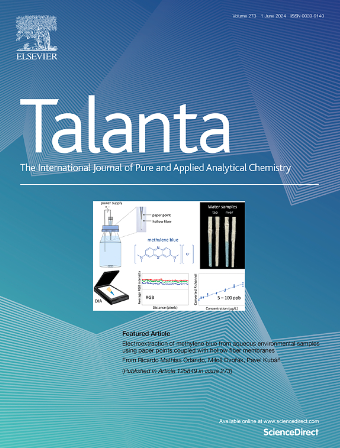Extracting the SERS characteristic features of SARS-CoV-2 and using machine learning to quickly screen positive specimens among hospitalized patients
IF 5.6
1区 化学
Q1 CHEMISTRY, ANALYTICAL
引用次数: 0
Abstract
The emergence of widespread viral transmission has prompted further development of early diagnostic methods, especially in situations where rapid and accurate testing is urgently needed. Label-free surface enhanced Raman spectroscopy (SERS) specimen classification through analytical chemistry combined with machine learning (ML) was shown to address such issue. However, the complexity of clinical specimens limit the qualitative interpretation, posing a challenge to the fast screening of clinical specimens. SERS-active substrates consisting of Au NPs/pZrO2 or Au NPs/fZrO2 were used to screen for SARS CoV-2 BA.2 variant among hospitalized inpatients. Nasopharyngeal and throat swabs were used, and their SERS spectra were distinguished. Full SERS spectra were extracted to distinguish CoV (+) and CoV (−) specimens to investigate the differences between ML of full SERS spectra and that of extracted spectral features. Nasopharyngeal specimens have shown to provide identifiable distinct features. Au NPs/fZrO2 exhibited better signal detection than Au NPs/pZrO2 owing to the filtering capability of the fibers, retaining only the virus particles on the surface. Full SERS spectra as input data in ML resulted in a sensitivity and specificity of 60 %; on the other hand, when extracted spectral features were used, a sensitivity of 100 % was exhibited by both substrates and specificities of 43 % and 57 % with Au NPs/pZrO2 and Au NPs/fZrO2, respectively. This study can quickly screen CoV (+) inpatients but is limited by the complexity of spectral profile affected by comorbidities, the number and diversity of inpatient specimens, and the need to further distinguish spectral profiles of CoV (−).

提取SARS-CoV-2的SERS特征特征,利用机器学习快速筛选住院患者中的阳性标本
病毒广泛传播的出现促使进一步发展早期诊断方法,特别是在迫切需要快速和准确检测的情况下。通过分析化学结合机器学习(ML)的无标签表面增强拉曼光谱(SERS)标本分类被证明可以解决这一问题。然而,临床标本的复杂性限制了定性解释,对临床标本的快速筛选提出了挑战。采用Au NPs/pZrO2或Au NPs/fZrO2组成的sers活性底物筛选住院患者SARS CoV-2 BA.2变异。使用鼻咽拭子和咽拭子进行SERS光谱的区分。提取全SERS光谱来区分CoV(+)和CoV(−)样品,研究全SERS光谱的ML与提取光谱特征的ML之间的差异。鼻咽标本已显示出可识别的明显特征。Au NPs/fZrO2比Au NPs/pZrO2表现出更好的信号检测能力,这是由于Au NPs/pZrO2纤维的过滤能力,只保留了表面的病毒颗粒。全SERS谱作为ML的输入数据,灵敏度和特异性为60%;另一方面,当使用提取的光谱特征时,底物对Au NPs/pZrO2和Au NPs/fZrO2的灵敏度分别为100%和43%和57%。本研究可以快速筛选CoV(+)住院患者,但受合并症影响的谱图复杂性、住院患者标本数量和多样性以及需要进一步区分CoV(−)谱图的限制。
本文章由计算机程序翻译,如有差异,请以英文原文为准。
求助全文
约1分钟内获得全文
求助全文
来源期刊

Talanta
化学-分析化学
CiteScore
12.30
自引率
4.90%
发文量
861
审稿时长
29 days
期刊介绍:
Talanta provides a forum for the publication of original research papers, short communications, and critical reviews in all branches of pure and applied analytical chemistry. Papers are evaluated based on established guidelines, including the fundamental nature of the study, scientific novelty, substantial improvement or advantage over existing technology or methods, and demonstrated analytical applicability. Original research papers on fundamental studies, and on novel sensor and instrumentation developments, are encouraged. Novel or improved applications in areas such as clinical and biological chemistry, environmental analysis, geochemistry, materials science and engineering, and analytical platforms for omics development are welcome.
Analytical performance of methods should be determined, including interference and matrix effects, and methods should be validated by comparison with a standard method, or analysis of a certified reference material. Simple spiking recoveries may not be sufficient. The developed method should especially comprise information on selectivity, sensitivity, detection limits, accuracy, and reliability. However, applying official validation or robustness studies to a routine method or technique does not necessarily constitute novelty. Proper statistical treatment of the data should be provided. Relevant literature should be cited, including related publications by the authors, and authors should discuss how their proposed methodology compares with previously reported methods.
 求助内容:
求助内容: 应助结果提醒方式:
应助结果提醒方式:


